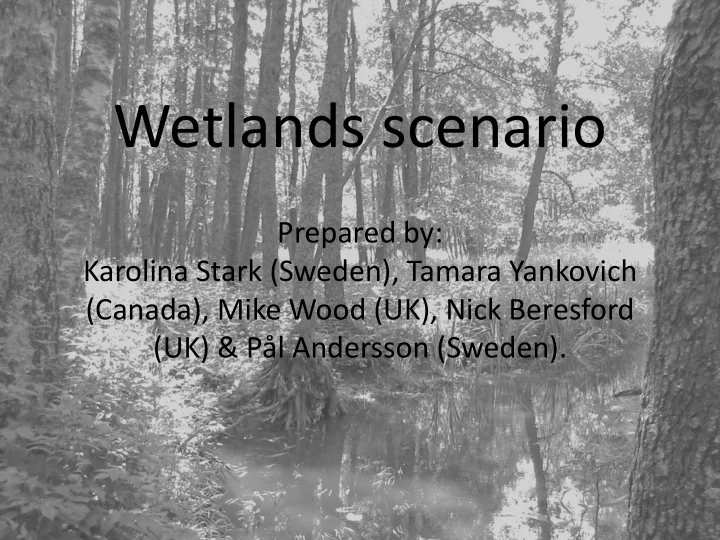

Wetlands scenario Prepared by: Karolina Stark (Sweden), Tamara Yankovich (Canada), Mike Wood (UK), Nick Beresford (UK) & Pål Andersson (Sweden).
Why this wetland scenario? • Most models consider terrestrial and aquatic ecosystems but not specifically wetlands. – How are modellers approaching a mixed ecosystem? – Are transfer parameters given for terrestrial and aquatic systems also valid for wetlands? • C14 media concentrations are available
Scenario in short • Participants are given measured radionuclide activity-concentrations in soil, water, and air from wetland areas, whereas few other parameters are specified in the scenario description.
Scenario in short • Participants are asked to estimate whole organism radionuclide concentrations in specified organisms including grasses, mosses, shrubs, trees, insects, small mammals, frogs and snakes. Resulting external and internal doses to these organisms should also be reported.
Scenario in short • Evaluation of the exercise will include model- model comparisons of whole organism activity concentrations and doses as well as model- measurement comparisons of whole organism activity concentrations and, for one species, external dose rate in soil.
Steel Creek, USA Reactor cooling water contaminated with Cs-137. Soil sampling along transects Creek water sampling Biota sampling: grass, bushes, ducks, frogs, snakes, insects, spiders.
Utnora, Sweden • Stream water contaminated with Cs-137 from Chernobyl floods the swamp. • Soil sampling in the swamp • Water sampling in the swamp • Biota sampling: trees, forbs, frogs • Frog phantoms in soil
DSS-01 DSS-03 DSS-02 Duke swamp, Canada DSS-06 DSS-04 DSS-05 DSS-10 DSS-09 DSS-08 DSS-07 DSS-14 DSS-17 DSS-18 DSS-15 DSS-12 • C-14 contamination DSS-16 DSS-11 DSS-13 DSS-22 DSS-26 DSS-21 DSS-25 of the swamp DSS-24 DSS-20 DSS-23 DSS-19 Waste management area DSS-33 through ground water DSS-30 DSS-32 DSS-31 DSS-29 DSS-28 DSS-35 Approx. 400 m • Soil and air sampling DSS-34 DSS-40 DSS-39 DSS-38 DSS-37 DSS-27 DSS-36 stations DSS-41 DSS-43 DSS-42 DSS-45 DSS-44 DSS-46 • Biota sampling: trees, DSS-52 DSS-47 DSS-49 DSS-51 DSS-50 DSS-48 forbs, grass, insects, DSS-58 DSS-56 DSS-55 DSS-57 DSS-54 DSS-53 frogs, snakes, small DSS-60 DSS-62 DSS-61 DSS-59 mammals. DSS-65 DSS-63 DSS-66 DSS-64 DSS-68 DSS-67 DSS-69 0 50 100 meters
What to do? • Best estimate of mean biota concentration for the species specified in instructions • For the comparison with measured biota data, best estimates of biota concentrations corresponding to min and max measured media activity concentrations.
What to do? • Mean internal and external dose rates should be reported. If appropriate, dose rates should be specified for the terrestrial and the aquatic part of the ecosystem.
Area Radionuclide Organism scientific name Steel Creek Floodplain Cs-137 Grasses, sedges Andropogon Steel Creek Floodplain Cs-137 Alder tree Alnus Steel Creek Floodplain Cs-137 Shrubs Myrica Steel Creek Floodplain Cs-137 Willows etc Salix Steel Creek Floodplain Cs-137 Green treefrog Hyla cinerea Steel Creek Floodplain Cs-137 Aquatic snakes Steel Creek Floodplain Cs-137 Terrestrial snakes Ducks (ringneck, mallard) Steel Creek Floodplain Cs-137 Spiders Araneae Steel Creek Floodplain Cs-137 Beetles Coleoptera Steel Creek Floodplain Cs-137 Aphids, leafhoppers, cicadas Homoptera Steel Creek Floodplain Cs-137 Grasshoppers, crickets Orthoptera Utnora Riparian Alder Swamp Cs-137 Spruce Picea abiea Utnora Riparian Alder Swamp Cs-137 Fern Matteuccia struthiopteris Utnora Riparian Alder Swamp Cs-137 Alder tree Alnus Glutinosa Filipendula ulmaria , Urtica dioica, Scirpus sylvaticus, Lysimachia thyrsifolia Utnora Riparian Alder Swamp Cs-137 Forbs, sedges Utnora Riparian Alder Swamp Cs-137 Moor frog Rana arvalis
Balsam fir Abies balsamea Duke swamp C-14 Cedar Thuja spp. Duke swamp C-14 Ferns Duke swamp C-14 Forbs Duke swamp C-14 Grass Duke swamp C-14 Peat moss Sphagnum spp. Duke swamp C-14 Duke swamp C-14 deer flies, horse flies, other types Aerial insects (mixed species) of flies, wasps and moths Carrion beetles Silphidae C-14 Duke swamp American toad Bufo americanus C-14 Duke swamp Grey treefrog Hyla versicolor C-14 Duke swamp American bullfrog Rana catesbeiana C-14 Duke swamp Green frog Rana clamitans C-14 Duke swamp Northern leopard frog Rana pipiens C-14 Duke swamp Mink frog Rana septentrionalis C-14 Duke swamp Common garter snake Thamnophis sirtalis C-14 Duke swamp Northern short-tailed shrew Blarina brevicauda C-14 Duke swamp White-footed mouse Peromyscus leucopus C-14 Duke swamp Deer mouse Peromyscus maniculatus C-14 Duke swamp Meadow vole Microtus pennsylvanicus C-14 Duke swamp
Recommend
More recommend